How to Make Curry Paste Out of Curry Powder
A Thai Red Curry Paste recipe that's doable by any home cook and yields a curry that truly is as great as what you get at the very best Thai restaurants. The DNA of this paste is a recipe by the great David Thompson, a highly regarded Thai food expert.
Like Green Curry Paste, a homemade curry paste yields the freshest, most fragrant curry that you can never buy in a jar. Use this red curry paste recipe for Thai Red Curry, fish cakes or add zing to Thai Fried Rice!
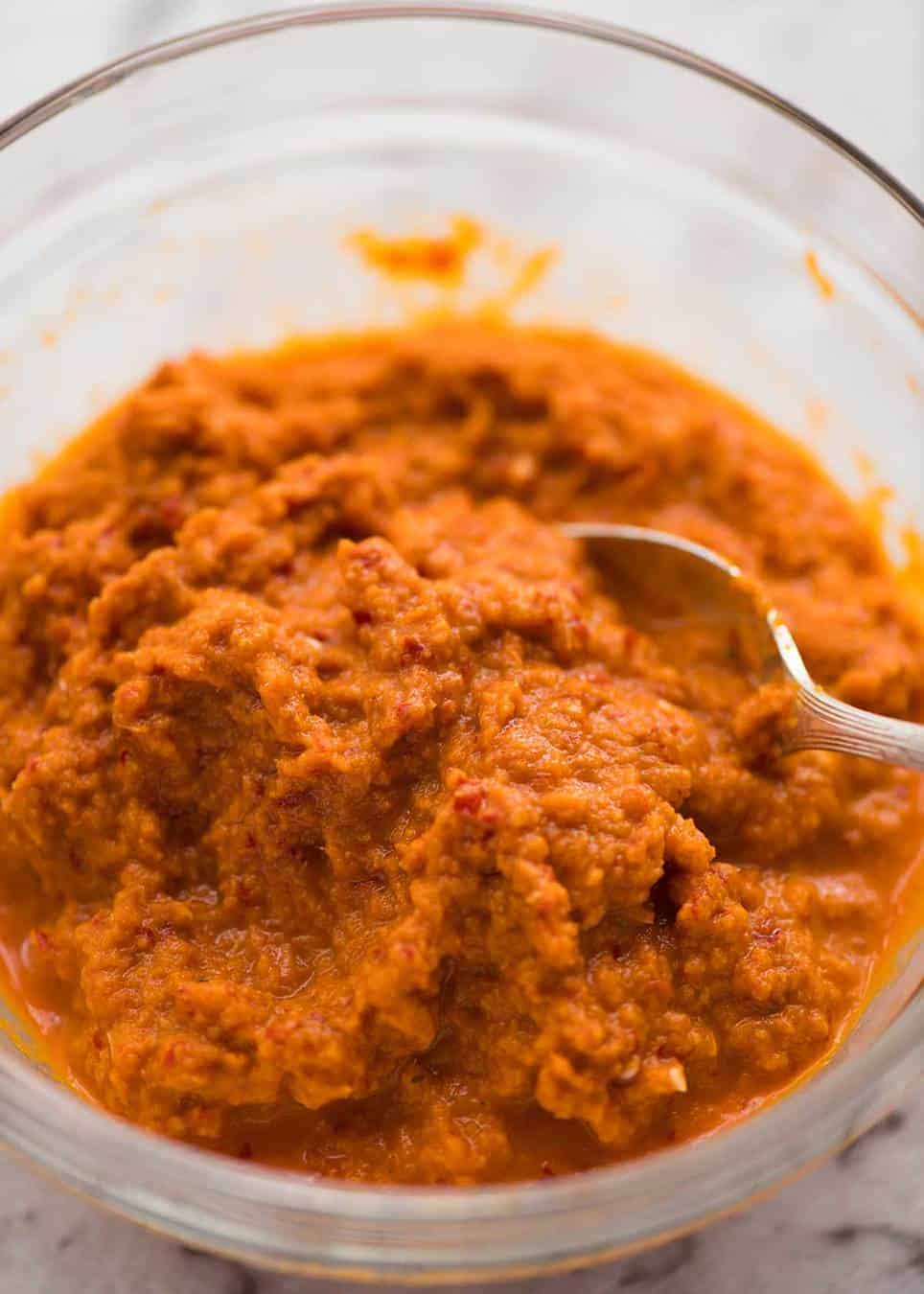
Thai red curry paste
This Thai Red Curry Paste recipe is a RecipeTin Family effort, refined over years with multiple family meals during which we critiqued the latest version.
We're a tough crowd, when it comes to each other. We don't hold back punches. You should have heard the critiques for the earlier versions. "It lacks complexity!" -> "Something's missing… I don't know what. Something's missing!"-> "It's nice, but it'sbrown not red." -> "Why is itgritty?" "The veggies are too soft, the chicken's not tender enough" -> "It's almost there! Almost!" ?
Actually, the cook is usually the toughest critic. We're pretty hard on ourselves!
But finally, the whole RecipeTin Family approves and we declare this curry paste to be The One. A Thai Red Curry Paste that's totally doable by any home cook that makes a Thai Red Curry that rivals those served by the best Thai restaurants in Sydney – and we are known for great Thai food here!
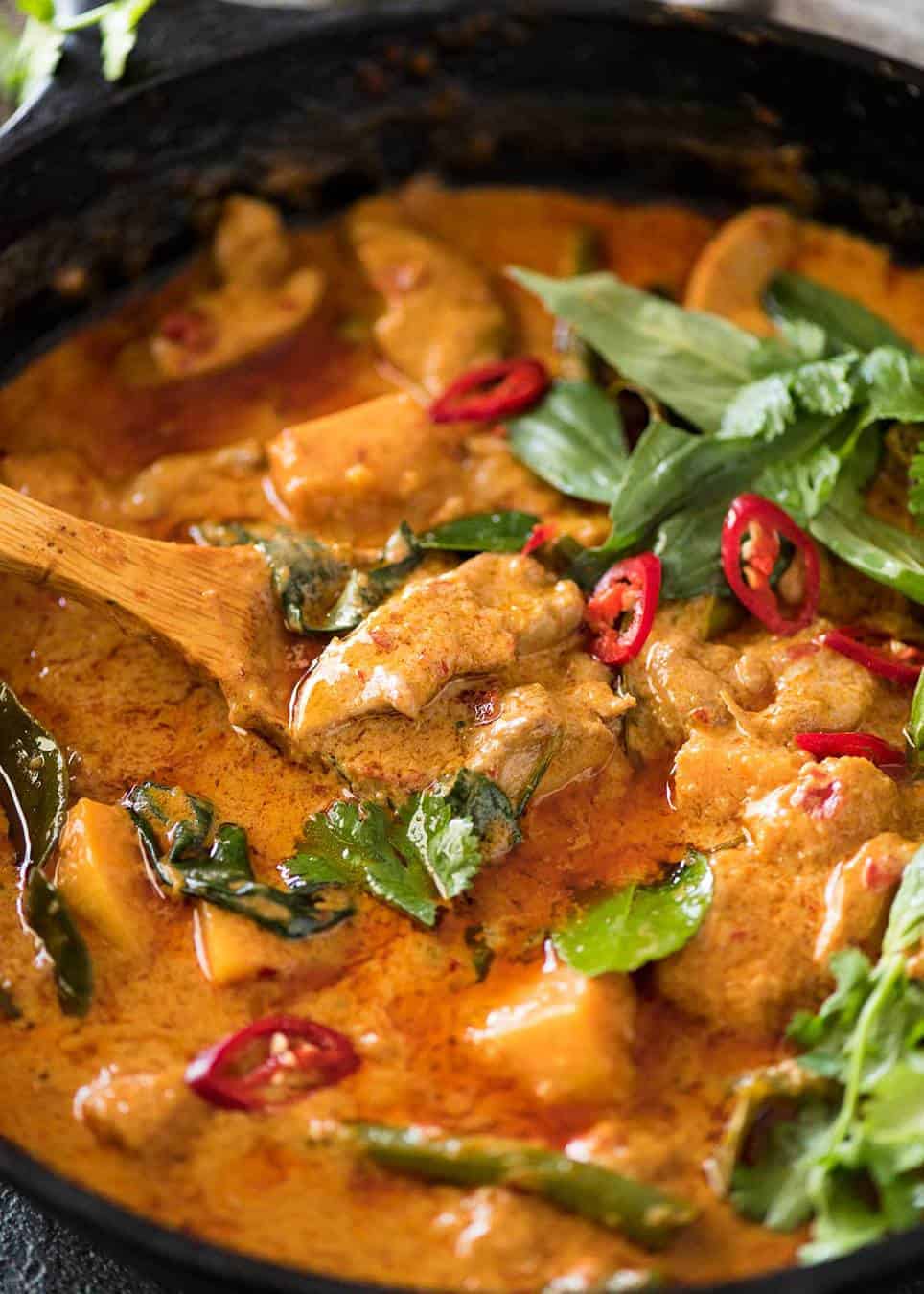
How Authentic Thai Red Curry Paste is made
Truly authentic Thai curry pastes require serious effort – the paste is made by grinding the ingredients in a mortar and pestle and it takes over 30 minutes. The first time I tried it, I was cursing like a sailor less than 10 minutes in, chilli bits flying everywhere.
The 2nd time I tried it, I gave up 3 minutes in and scraped everything into a blender.
Blender is the way to go. Blender all the way!!!
Much of the base for this Thai Red Curry Paste is drawn from Chef and restaurant recipes. Little tweaks here and there to balance it to my taste to make it as close as I could to the red curries served at my favorite Thai restaurants.
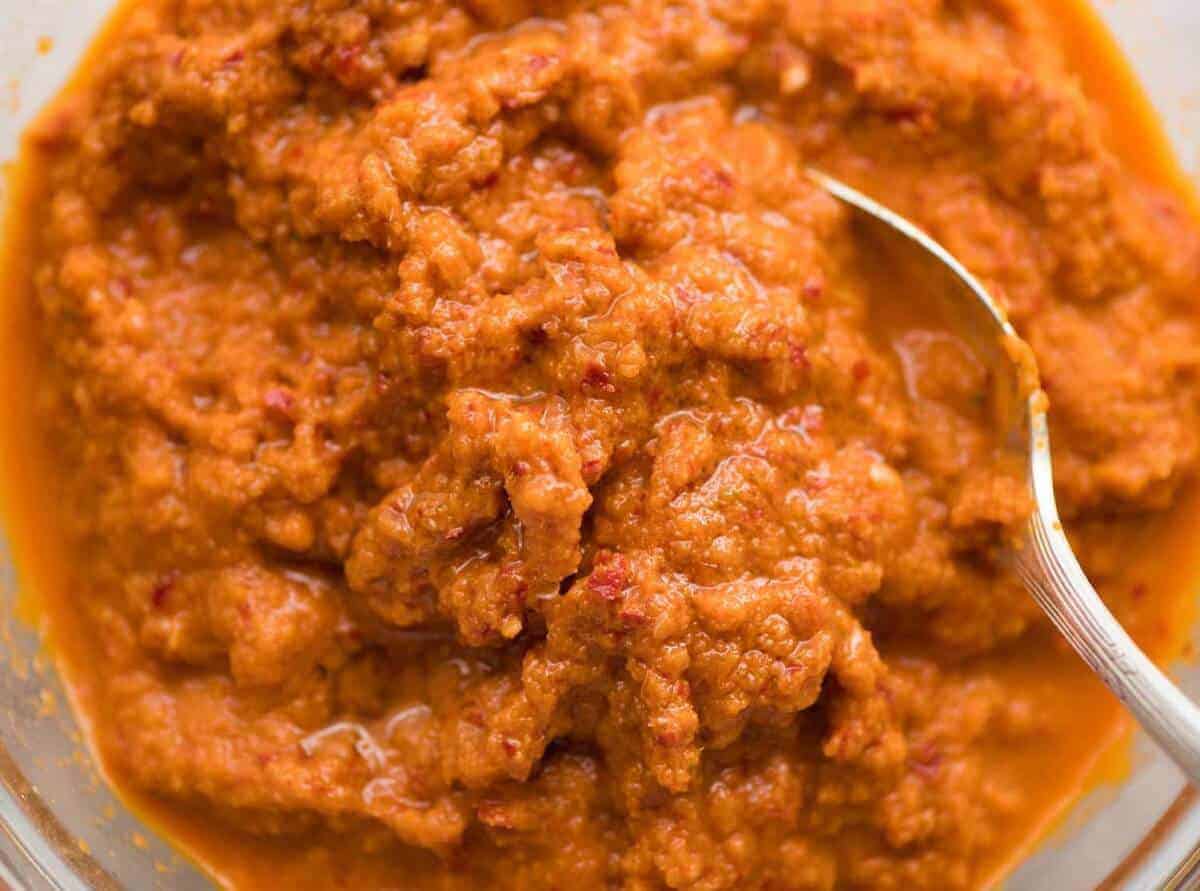
What goes in Thai Red Curry Paste
There's no denying that you'll probably require a trip to the Asian grocery store to get all the ingredients for Thai Red Curry Paste, unless your local supermarket has an exceptionally well stocked Asian section! But everything should be relatively simple to hunt down, they are all pretty common Asian ingredients. Just show the shop keeper these photos if you can't find them!
The star ingredient in Thai Red Curry is dried red chillies. Chop before hydrating in boiled water to shake the seeds loose (seeds = spiciness) and also, they hydrate better = easier to whizz into a smooth paste.
Using fresh red chillies won't produce the same end result, I tried. Dried chillies have an earthy flavour, they are not crazy spicy and it's a key flavour base for red curry.
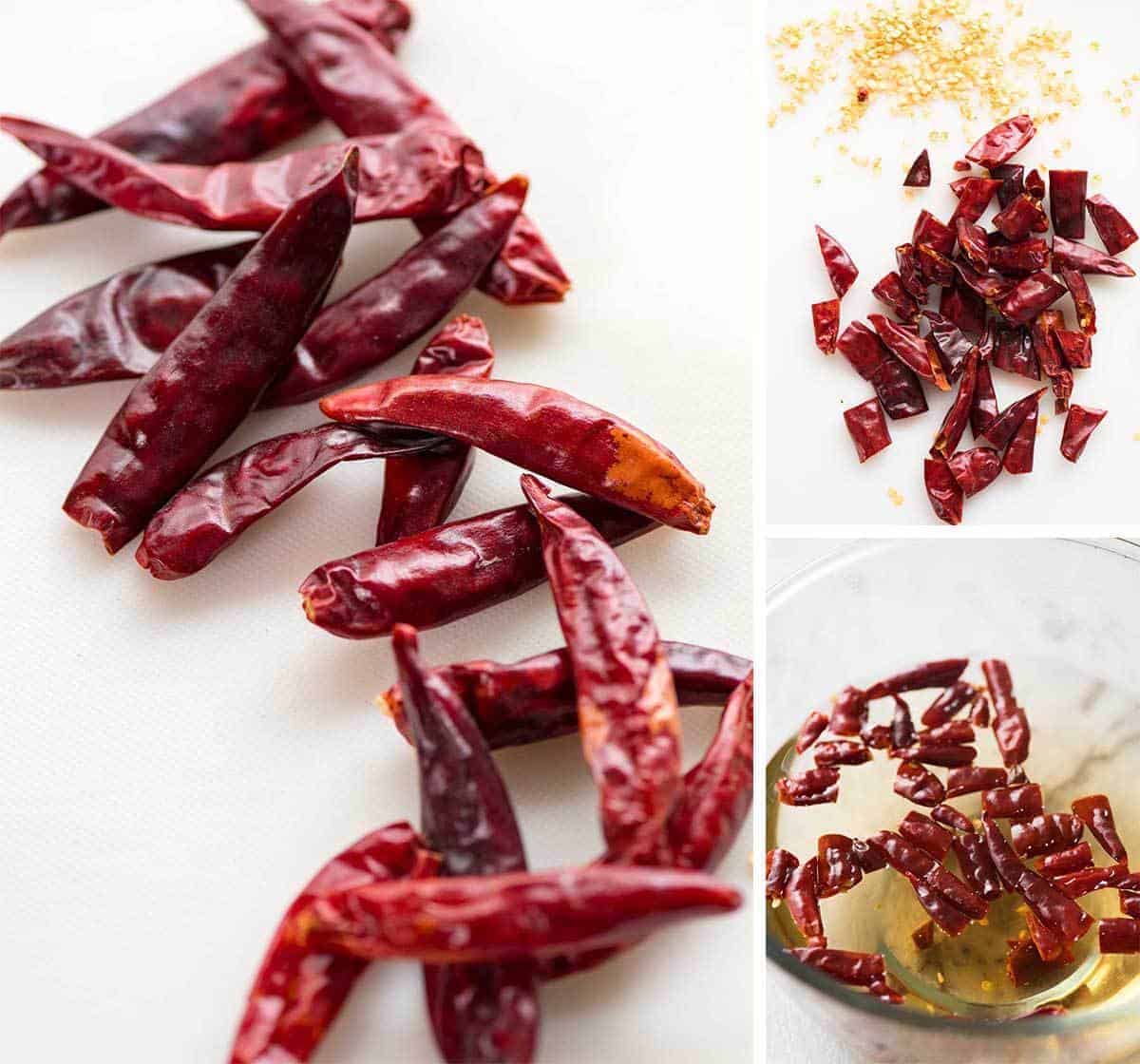
Another ingredient in Thai Red Curry Paste that is a bit unique is galangal. It looks like ginger, but tastes more citrusy and is harder to cut. If you can't find it, substitute with ginger and lime zest.
Because galangal is so tough, it can be one of the offenders of grainy curry sauce because consumer grade blenders and food processors can't blitz it finely enough if you just throw chunks in. In our Red Curry Paste readings, we never came across a recipe that called for galangal to be grated. But this step is truly worth taking if you want to ensure your curry is smooth, especially if you have an ordinary blender. I have a powerful Vitamix blender, and I still grate my galangal.
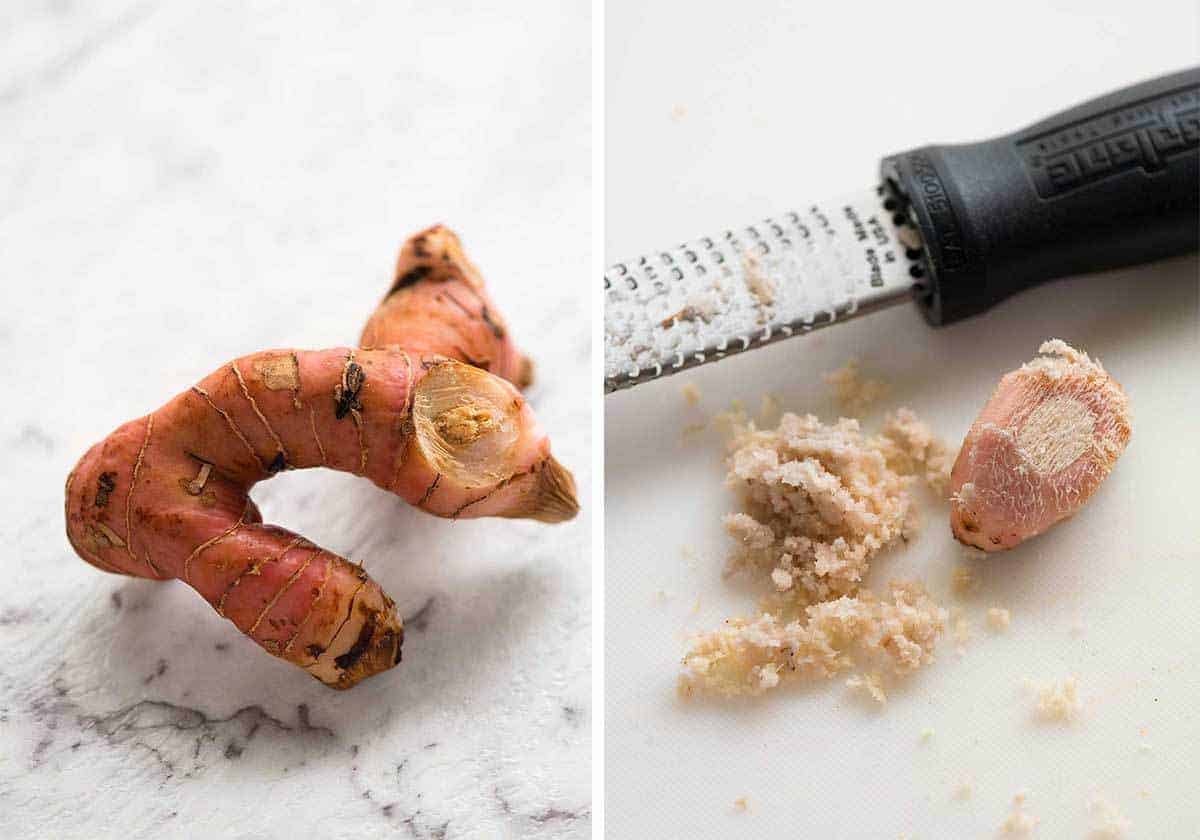
The other key ingredient in Thai Red Curry Paste is Shrimp Paste. This is where our recipe differs from some authentic Thai recipes. Made from fermented, dried shrimp (prawns), most Thai recipes use pure shrimp paste which is called Belacan. Typically, it's sold in dried blocks which is required to be soaked to rehydrate before use.
However, we like to use Shrimp Paste that comes in a jar with oil and some other flavourings added. This is a tip I picked up from Sujet Saenkham, the chef of the very popular Spice I Am Thai restaurants in Sydney, and it was our final tweak that took our curry from"it's almost there!" to "YES!!!! This is truly restaurant quality!!!!". ( <- OK, there may have been a little jiggy upon the first taste test).
The main reason I use this is for the oil because this is the key thing we noticed between hand grinding and using a blender – the extraction of natural oils from the chilli. You can't achieve this using a blender, only grinding by hand.
Solution: Use Shrimp Paste in oil. There are many brands out there. I use Por Kwan which is the most popular brand at Asian supermarkets here in Australia. Just check the jar and as long as it has more than just shrimp and salt in the ingredients, it should be just fine.
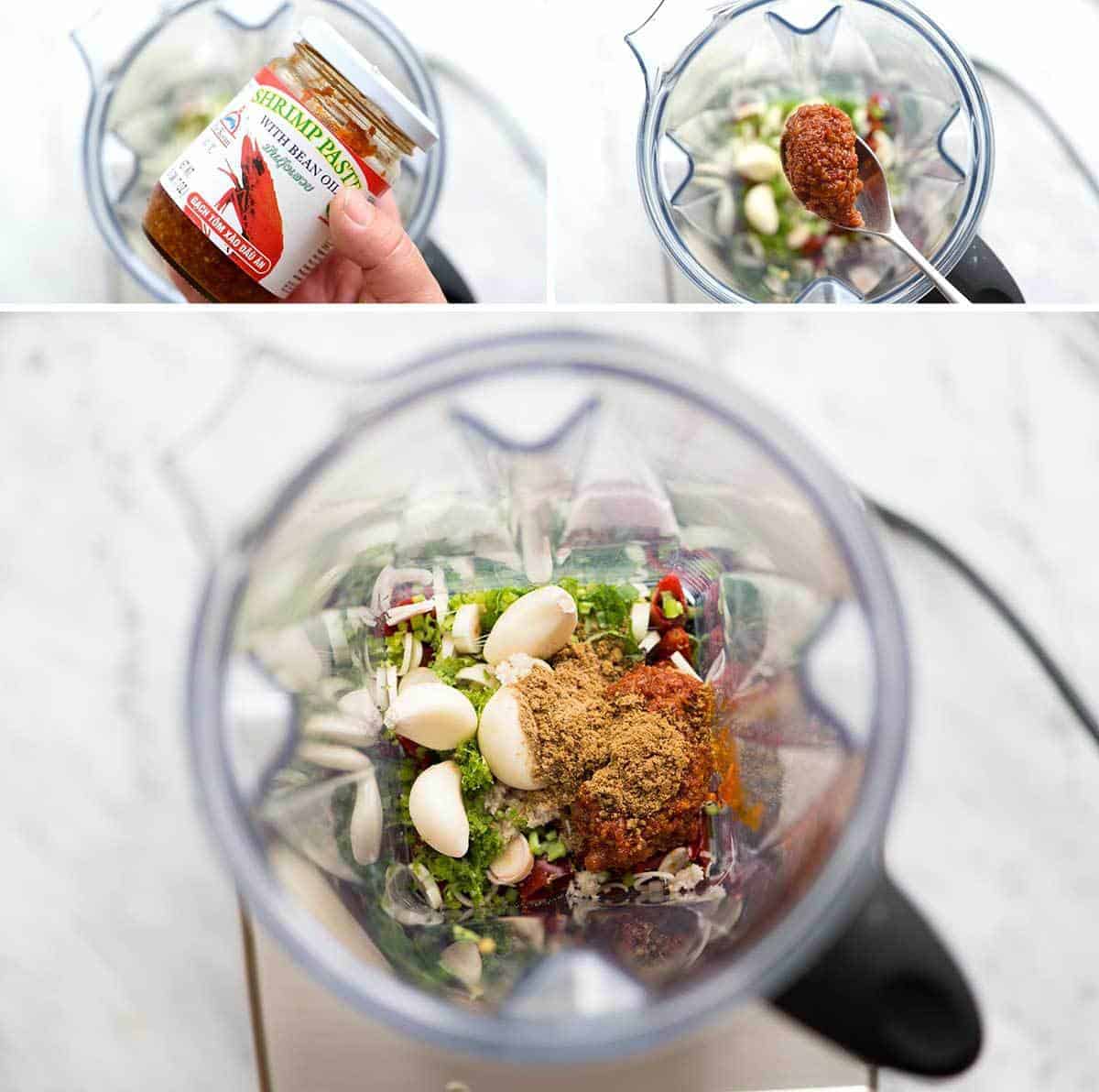
The other ingredients in Thai Red Curry Paste are more familiar every day ingredients: lemongrass, coriander / cilantro, eschalots / shallots (baby red onions) and lime.
Plonk it all into the blender, and blitz away until smooth – this can take a good 30 seconds or even up to 1 minute, depending on how powerful your blender is.
And this is what it looks like when it comes out – kind of more orangey than a deep red (PS Curry paste in jars usually has colouring). You'll be strangely disappointed when you do a taste test – it doesn't taste like anything amazing. Have faith, my friends, have faith!
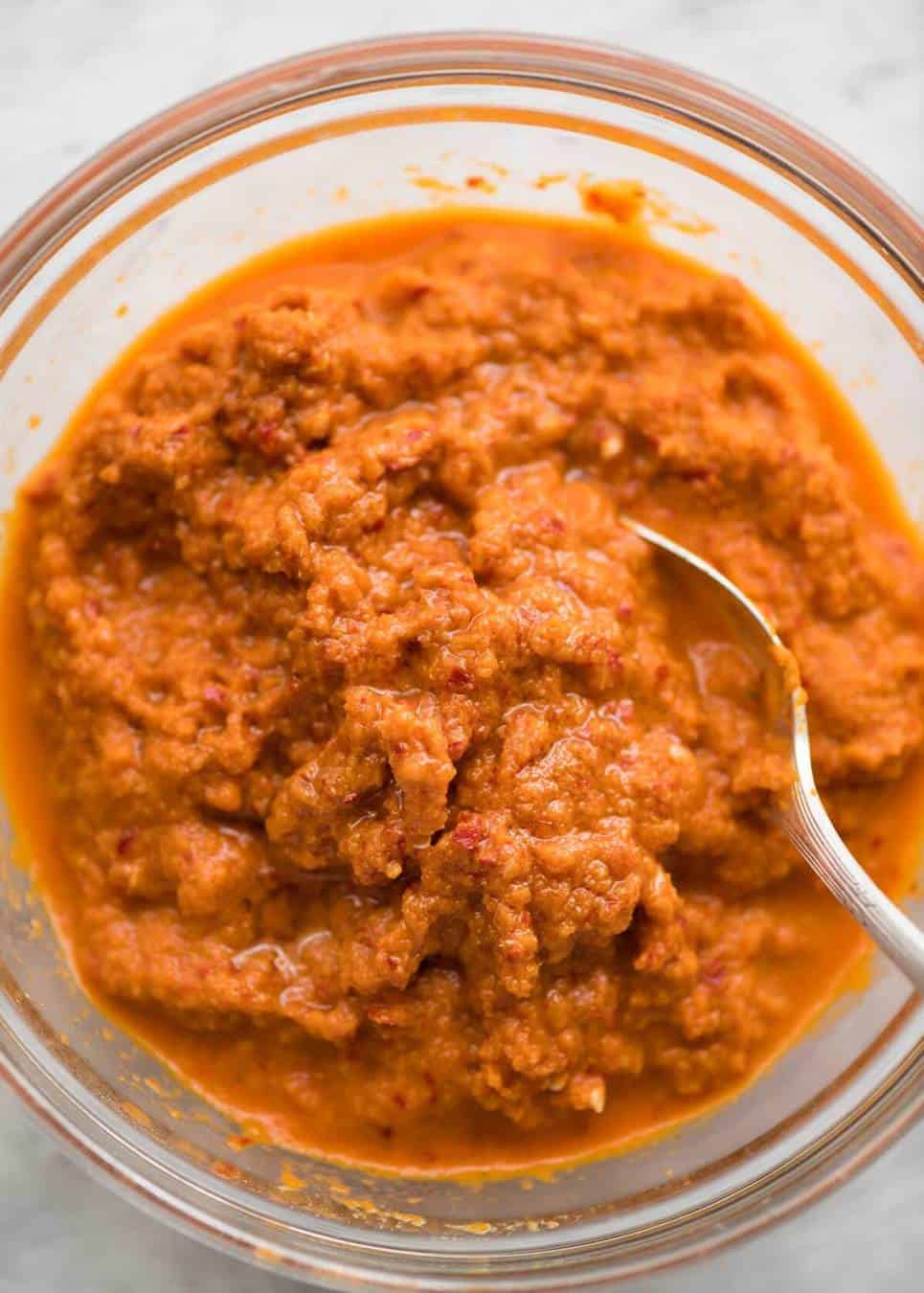
Thai Red Curry Paste is a base for many Thai dishes, from Thai Fish Cakes to stir fries, fried rice to noodles. But the most well known use is probably Thai Red Curry.
If you've ever made red curry using store bought taste, you will be blown away how much better made from scratch is. If you're Thai Food connoisseur, you'll be astonished how close this is to the red curries served at great Thai restaurants. The likes of Longrain, Spice I Am, Chat Thai, Sailors Thai and Khao Pla – the red curries at these restaurants were our benchmark.
We hope you enjoy this as much as we do! – Nagi x
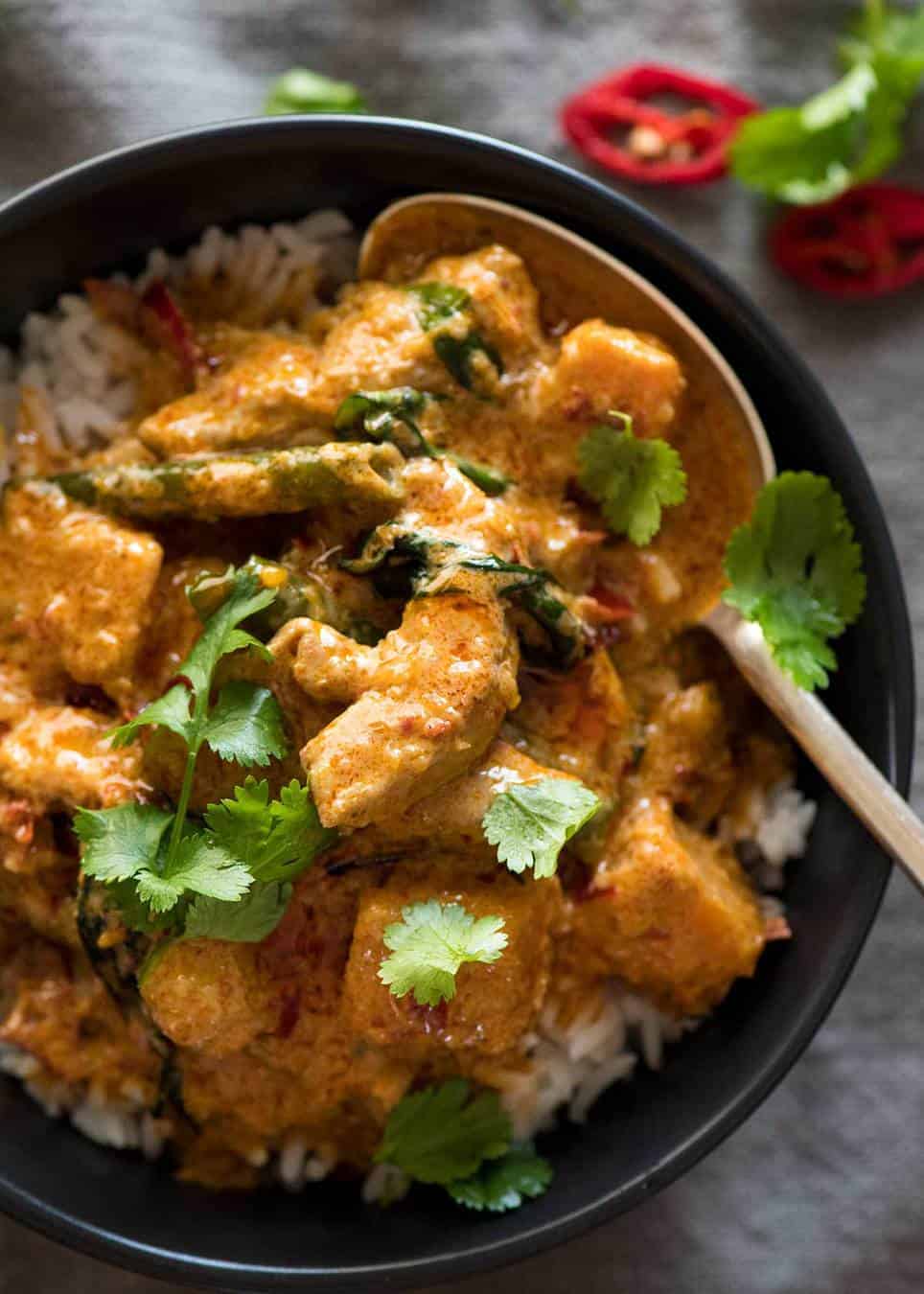
WATCH HOW TO MAKE IT
Subscribe to my newsletter and follow along on Facebook, Pinterest and Instagram for all of the latest updates.
Servings 1 cup
Tap or hover to scale
Developed over years by the RecipeTin Family, this is our Thai Red Curry Paste recipe that will make a curry that is truly tastes like what you get at great Thai restaurants. Guided by world renowned Thai Chefs, this is a Thai Red Curry paste recipe that's doable for any home cook that we truly believe stacks up to the best of what you'll get at restaurants. See post for more background information. Use this to make Thai Red Curry!Recipe VIDEO above. Enjoy!
- 16 dried chillis , chopped into 1 cm / 0.5" pieces seeds shaken out (Note 1)
- 2 tbsp lemongrass , sliced, reedy outer skin removed (1 large) (Note 2)
- 1 tbsp grated galangal, peeled and grated (Note 3)
- 4 garlic cloves, peeled whole
- 1 tbsp shrimp paste in oil (Note 4)
- 1/2 tsp ground coriander
- 1/2 tsp ground cumin
- 1 tbsp chopped coriander/cilantro stem and roots (Note 5)
- 2 red shallots , peeled and roughly chopped (Note 6)
- 1 tsp lime zest
- ¼ cup reserved chilli soaking water
-
Taste dried chillies for spiciness - see Note 1. Place the chopped chillies in a large boil and pour over about 3 cups of freshly boiled water. Leave to soak for a good 30 minutes or so.
-
Remove chillis and reserve water.
-
Put chillis in a blender or powerful food processor.
-
Add remaining curry paste ingredients into the blender along with 1/4 cup of the chilli soaking water.
-
Blitz on high until smooth - test by rubbing between your fingers. It takes around 20 seconds in my Vitamix which is a powerful blender. It might take up to 1 minute. Use a touch more water as required to aide with blending.
-
Scrape into a bowl or airtight container. Store for up to 3 days in the fridge, or freeze it to use later.
-
Use in place of store bought curry paste in recipes that call for it - especially Thai Red Curry!
1. Spiciness - This curry paste is supposed to be quite spicy but not totally blow-your-head-off. This recipe is made with the generic Asian dried chillies purchased from Asian grocery stores which are usually not that spicy, it's more about the flavour they bring to curries. But in this recipe, we use a LOT of the dried chillies as they are the key flavour base, so they do make the paste spicy.
The spiciness of chillies (dried and fresh) is like playing roulette - at different times of the year, they go up and down. The only way to really control how spicy your curry will be is to taste the chilli. If it's not that spicy, proceed with the recipe.
But if it's spicy, then feel free to dial it back!
It is not made with the small Thai Chillies which are considerably spicier.If using dried Thai chillies, use 6 - 8.
You can substituted with other dried red chillies but always check spiciness first!
2. 1 lemongrass with a thick stem is usually sufficient. Peel the tough green outer layers and slice the inside.
3. Galangal looks like ginger but is more citrusy and harder. It's actually pretty hard to cut. Most recipes will tell you just to toss in chunks, but unless you have an extremely powerful blender or food processor, there's a strong chance you end up with grainy curry. So I strongly recommend grating it - it's the best way to ensure it blends in.
You can find it in some grocery stores in Australia (Harris Farms and some Woolworths sell it). If you can't find it, use the same amount of ginger + the zest of 1 lime (in addition to what is already in the recipe).
4. Shrimp Paste - I use Por Kwan Shrimp Paste in Bean Oil, the most popular one sold at Asian grocery stores here in Australia. (Here are some online links - for Australia and America). While many authentic recipes will say to use ordinary shrimp paste which is made with just fermented shrimp and salt (it comes either in small jars or dried blocks), we find that using Shrimp Paste sold in jars where other flavouring have been added (mainly oil, a bit of garlic, and soy sauce powder) goes a long way to making a truly restaurant quality curry paste. This is especially so when using a blender instead of mortar and pestle as when dried chillies are ground by hand, the natural oils are extracted. So using a shrimp paste in oil makes up for this.
If you can't find Shrimp Paste in oil, Belacan is an adequate substitute which, believe it or not, is sold at Woolworths in Australia. Use 2 teaspoons, just sort of crumble it to measure out and put it straight into the blender. No need to rehydrate, like when used in other recipes.
5. Coriander roots / stems - you'll find that authentic recipes call for coriander roots which has great coriander flavour. In Western grocery stores and most Asian stores (at least, here in Australia), coriander is typically sold with barely any roots at the base of the bunch. Cleaning the little roots there are is a pain, and if you don't clean it well, you end up with dirt grit in the sauce. So I get around this by using the stem instead - and more of it. Fresh coriander in any form is not a major ingredient in the curry paste because you lose so much of the flavour when it is sautéed for the curry, so don't get too hung up about this.
6. Eshalots are the baby red onions. Sometimes called red shallots, French shallots.
7. Blender vs food processor - because of the quantity of paste, I find it works better to use a blender and also typically, blenders are more powerful than food processors. I have a Vitamix blender which is very powerful, ideal for making red curry paste. This will work in a food processor as long as it's a decent powered one, and if yours is a large food processor, it's best to use the insert.
8. USES: Use this homemade Thai Red Curry Paste in place of store bought in recipes that call for it. The most common use is Thai Red Curry. Red Curry Paste is also a key flavour base for many other Thai dishes, from soups to curries to stir fries, and Thai Fish Cakes.
9. References: Over the years, we have referenced many sources in arriving at what we believe is the perfect balance of flavours. This includes some of the best Thai Chefs in the world, including David Thompson (Australia's Michelin starred Thai food expert), Sujet Saenkham (of Australia's popular Spice I Am Thai Restaurants), Sailors Thai, Chat Thai, Khao Pla, Gourmet Traveller, Chinta Rhia. We also referenced this Authentic Thai Red Curry Paste recipe from Eating Thai Food. We would say the DNA of our recipe is from David Thompson.
LIFE OF DOZER
This is his scary face. Can't take him seriously!

How to Make Curry Paste Out of Curry Powder
Source: https://www.recipetineats.com/thai-red-curry-paste/

0 Response to "How to Make Curry Paste Out of Curry Powder"
Post a Comment